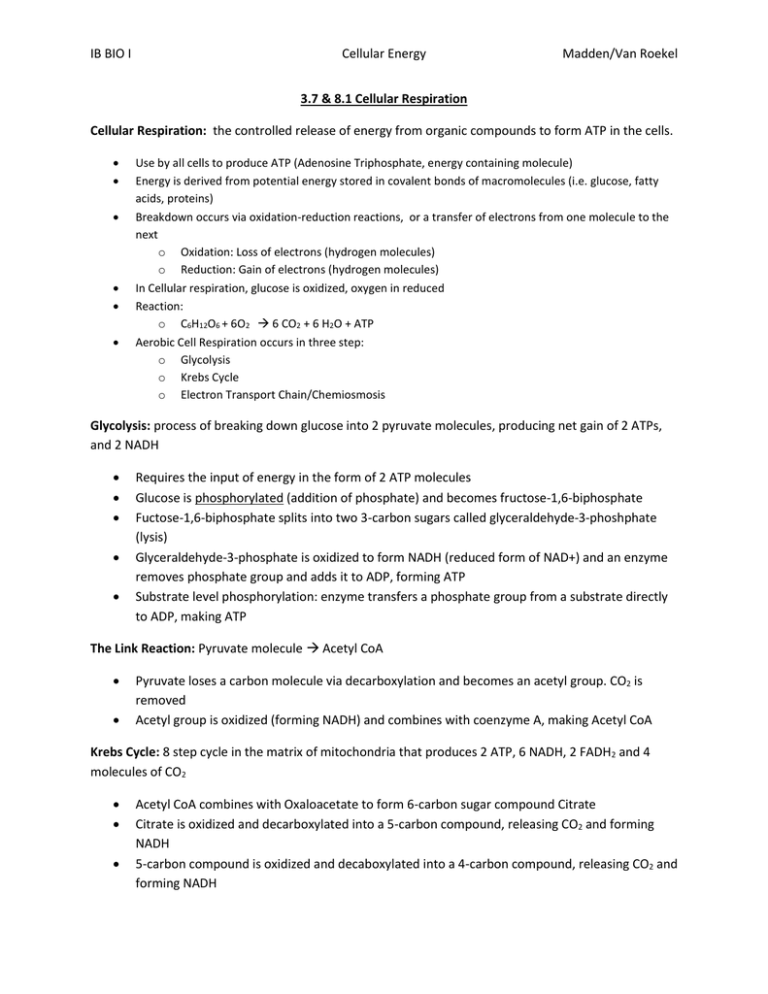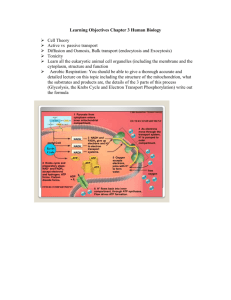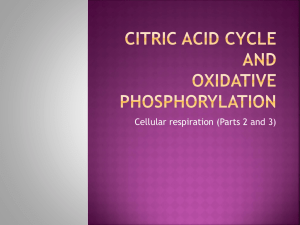IB BIO I Cellular Energy Madden/Van Roekel 3.7 & 8.1 Cellular
advertisement

IB BIO I Cellular Energy Madden/Van Roekel 3.7 & 8.1 Cellular Respiration Cellular Respiration: the controlled release of energy from organic compounds to form ATP in the cells. Use by all cells to produce ATP (Adenosine Triphosphate, energy containing molecule) Energy is derived from potential energy stored in covalent bonds of macromolecules (i.e. glucose, fatty acids, proteins) Breakdown occurs via oxidation-reduction reactions, or a transfer of electrons from one molecule to the next o Oxidation: Loss of electrons (hydrogen molecules) o Reduction: Gain of electrons (hydrogen molecules) In Cellular respiration, glucose is oxidized, oxygen in reduced Reaction: o C6H12O6 + 6O2 6 CO2 + 6 H2O + ATP Aerobic Cell Respiration occurs in three step: o Glycolysis o Krebs Cycle o Electron Transport Chain/Chemiosmosis Glycolysis: process of breaking down glucose into 2 pyruvate molecules, producing net gain of 2 ATPs, and 2 NADH Requires the input of energy in the form of 2 ATP molecules Glucose is phosphorylated (addition of phosphate) and becomes fructose-1,6-biphosphate Fuctose-1,6-biphosphate splits into two 3-carbon sugars called glyceraldehyde-3-phoshphate (lysis) Glyceraldehyde-3-phosphate is oxidized to form NADH (reduced form of NAD+) and an enzyme removes phosphate group and adds it to ADP, forming ATP Substrate level phosphorylation: enzyme transfers a phosphate group from a substrate directly to ADP, making ATP The Link Reaction: Pyruvate molecule Acetyl CoA Pyruvate loses a carbon molecule via decarboxylation and becomes an acetyl group. CO2 is removed Acetyl group is oxidized (forming NADH) and combines with coenzyme A, making Acetyl CoA Krebs Cycle: 8 step cycle in the matrix of mitochondria that produces 2 ATP, 6 NADH, 2 FADH2 and 4 molecules of CO2 Acetyl CoA combines with Oxaloacetate to form 6-carbon sugar compound Citrate Citrate is oxidized and decarboxylated into a 5-carbon compound, releasing CO2 and forming NADH 5-carbon compound is oxidized and decaboxylated into a 4-carbon compound, releasing CO2 and forming NADH IB BIO I Cellular Energy Madden/Van Roekel 4-carbon sugar undergoes a variety of chemical and conformational changes, forming NADH, FADH2 and ATP (by substrate level phosphorylation). 4-carbon compound is also changed to re-form starting compound, Oxaloacetate For Each glucose molecule, Krebs Cycle completes two revolutions Electron Transport Chain (ETC)/Chemiosmosis: Involves the use of the ETC and ATP synthase to generate a large amount of ATP and water ETC is a collection of molecules on the inner mitochondria membrane, mainly protein, that accept and donate electrons along an energy gradient o FMN: Flavin mononucleotide, accepts electrons from NADH o FE-S: Iron Sulfur protein accepts electrons from FADH2 o Coenzyme Q (ubiquinone) is a lipid o Cytochromes (cyt) contain heme group for binding electrons Accept electrons from NADH/FADH2, and pass them from one protein to the next Occurs because of electronegativity; higher electronegativity=stronger electron attraction Small amount of energy between protein carriers, less energy released, easy to harness Oxygen is final electron acceptor; combines with two hydrogen ions and leaves as water Does not produce ATP directly Couples with ATP synthase to produce ATP in a process called chemiosmosis Chemiosmosis involves the movements of protons (hydrogen ions) by ETC to provide energy for phosphorylation Creates a hydrogen ion (H+) gradient that results in a proton-motive force, which can be used to power ATP synthase H+ ions move passively through ATP synthase, and using energy gained from ions, synthase can combine ADP and phosphate to form ATP. Formation of ATP through this process is referred to as oxidative phosphorylation Cell Respiration Review Energy flow: GlucoseNADHETCChemiosmosis (proton-motive force) ATP Theoretical production of ATP: 36 Outer Mitochondrial Membrane Inner Mitochondrial Membrane Cristae Matrix Inter-membrane Space Actual Production of ATP: 30 Separates contents of Mitochondrion from cell Contains proteins for ETC and ATP synthase for chemiosmosis Tubular regions of IMM to increase surface area for oxidative phosphorylation Cytosol like (liquid) area of mitochondria, contains enzymes for Krebs Cycle Reservoir for H+ ions (necessary for chemiosmosis)





